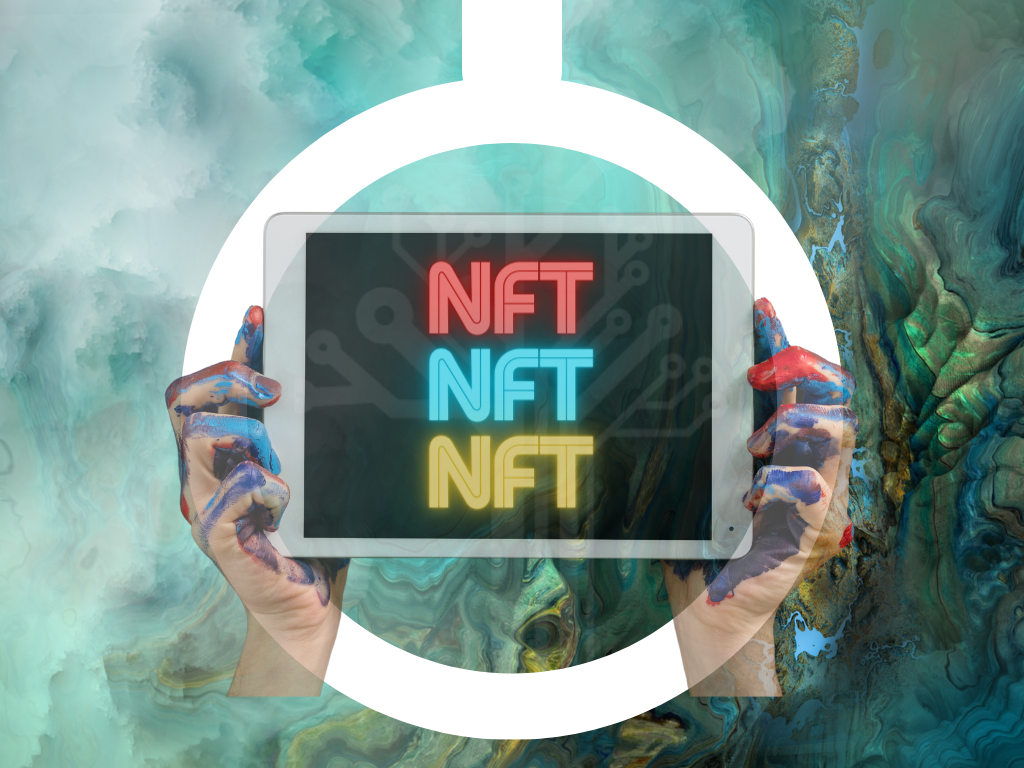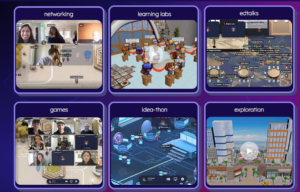NFT in Edu: What Does the Future Hold?
Key Points
-
In education, NFTs have become a topic of conversation.
-
Students are interested in learning about NFTs and discussing what it means for the future and for education, and even brainstorming what they would create.
-
We can expand access to careers in human expression while leveraging the emerging technologies in our future.

NFTs (or non-fungible tokens) have become a hot topic in conversations when it comes to emerging trends in technology. Even though it feels like they are something new, the first NFT was actually launched in 2017 by CryptoPunks. Now, NFTs are now being used at an increasing rate and value every day. In one year, the value of NFTs in the market has increased from $340 million to $14 billion dollars. There are many areas of work where people are starting to use NFTs and one question many are asking is, “What role could NFTs play in education in the future?
What are NFTs?
According to the Merriam-Webster definition, a nonfungible token (NFT) is a unique digital identifier which cannot be copied, substituted or subdivided. Once created, the NFT is then recorded in a blockchain which is used to certify its authenticity and ownership. An NFT is not a tangible object but rather a form of proof that shows ownership and purchase. These blockchain-based tokens can represent artwork, digital content, media or even event tickets. An NFT is an irrevocable digital certificate of ownership and authenticity for a digital or physical asset.
NFTs have unique digital identifiers and are stored on a blockchain, a system that is used to keep a record of transactions made in bitcoin or some type of cryptocurrency. NFT records are kept across multiple computers that are linked in a network and through the blockchain, can be sold or traded. NFTs are created through a process called “minting,” in which they convert digital files into a cryptocurrency collectible. The process of minting is how NFTs are uploaded to the blockchain.
A difference between bitcoin and NFTs is that bitcoin can be traded for another bitcoin, whereas NFTs are unique and cannot be traded as an equal value. In my eighth grade STEAM class, I shared this video explainer which provides some examples to help students and teachers better understand NFTs. One example shows how a $100 bill can be divided up into different amounts but keeps the same value. However, when it comes to NFTs, in art for example, you cannot take a painting like the Mona Lisa, divide it up, and equally distribute it because there is only one original Mona Lisa. That’s where the value of NFTs comes in, especially in areas like music and art. While you may be able to print a copy or take a picture of it, the value will not be the same as the original. Because of the ability to forge works of art or music, which makes it difficult to identify whether or not it is an authentic piece, this is where NFTs can be highly beneficial.
How are NFTs created?
NFTs are created by artists, designers or license holders through a process referred to as “minting.” Minting involves signing a blockchain transaction that provides the specifics or outline of the fundamental token details. NFTs can take various forms whether it is a photo, video, or even a GIF. The information is then sent to the blockchain to trigger a smart contract function which creates the token and assigns it to its owner. Each NFT has a unique identifier which is then stored on the blockchain. Once it is on the blockchain, it sets the authenticity and the ownership.
Where are NFTs being used in education?
In education, NFTs have become a topic of conversation. Over the past few months in my STEAM course on emerging technology, we have explored bitcoin, cryptocurrency, blockchain, and NFTs. Students are interested in learning about NFTs and discussing what it means for the future and for education, and even brainstorming what they would create. There are several universities that are using NFTs for credentialing and also for working in remote learning environments. One example is Duke University which has provided educational credentials in the form of NFTs for its Master of Engineering in Financial Technology degree.
Other universities are exploring some unique uses of NFTs. Seton Hall University held an Annual Entrepreneur Hall of Fame Dinner in February and alumni were presented with NFT awards. At Pepperdine University, one educator has been using NFTs in a personal finance course to award NFTs to the students. The NFTs represent academic tokens, without monetary value, that represents when a student has passed the course. The NFT contains unique details about student performance. MIT has done research and has been advocating for the use of blockchain for authenticating college certificates and transcripts.
Students are interested in learning about NFTs and discussing what it means for the future and for education, and even brainstorming what they would create.
Rachelle Dené Poth
NFT’s may also be used in the future in order to give people permission to events and to better manage which parts of the event people have access to. Over time, this may even become some kind of alumni status, i.e. special rewards or privileges to those who have attended SXSW EDU 5 years in a row, etc.
What does this look like in K-12?
At a high school level, think about times when we use assessments for learning or we share evidence of work that students have done whether that comes in the form of a certificate, maintaining student records, accessing results from a standardized test, or recording other academic achievements. These require time to obtain and to store and in some cases, can easily be forged. With so much technology available, we can make certificates and other documents look authentic. However, with NFTs and the inability to forge them, schools are likely going to consider using NFTs for a variety of reasons.
When a student or teacher does well, to make it memorable, the academic sector can now create and design an NFT. The use of NFTs as diplomas and resumes could help better track and access what students have earned throughout their school careers. By using NFTs, it serves to stop students from falsifying their academic certifications because the token serves as a permanent, unchangeable and unique “transcript.” There are many ways NFTs are being used now and which can benefit various areas of work and life. Rabbi Michael Cohen, educator and author, has been doing a lot of work in the area of NFTs and even holds a Twitter Spaces chat on Tuesday nights about it. He sees the potential for using NFTs for creativity and in the arts.
Mark Cuban, a billionaire and investor on NFT platforms, believes that textbooks will become part of the NFT experience. Digital textbooks can be resold and royalties can be collected for each resale.
Preply, a global language learning platform founded in 2012, minted three NFTs on Open Sea as a way to reward tutors in 2021. Amy Pritchett, the Student Success Manager of Preply says: “We wanted to experiment with NFTs as a way to reward Preply tutors and the great education they provide our students. Once you have one of these tokens you can keep it or sell them. Pritchett added some ideas for using NFTs such as creating online ‘trophy cases’ of their NFTs as artifacts or perhaps creating digital portfolios, which can be shared with prospective employers or even college admissions. Teachers can also issue NFTs to represent when students successfully demonstrate learning the class material. Pritchett added, “We are only starting to see the beginning of how NFTs and education can come together. They are an emerging trend that we all continue to be curious about.”
What is the difference between NFTs and Verifiable Credentials?
Both NFTs and verifiable credentials (VC) offer ways to uniquely identify something in the digital space. NFTs are publicly displayed and VCs are a privately held digital fact, however, each of these spaces provides more security and authenticity, and are capable of being monetized. Each proves that something, whether a token or a piece of art, belongs to someone. However, there are differences. A VC uses link key infrastructure and has three entities: the issuer, the holder, and the verifier of the credential. Each party signs the license and gives it the authentication. An example would be a driver’s license. An NFT can only exist on the blockchain and as soon as it is created, everything is time-stamped which makes it easier to verify ownership. NFTs can be monetized by creating something new and then selling it whereas a VC cannot be tampered with and all information is verified cryptographically to prove the identity of the individual or entity. NFTs can be transferred, but VCs cannot, which means that the original owner remains the same.
The value of NFTs
The value of NFTs are determined by the availability of a digital asset or what it represents. If few are in existence then the value will be greater. Earlier last year, digital artist Beeple sold Everydays, a collage of 5,000 images for $69.3 million and Jack Dorsey, Twitter CEO sold the first tweet he made as an NFT for $2.9 million. Podcast Host has launched the “world’s first-ever generative podcast NFT collection” under the branding of “The Curious Companion” introducing a new medium into the world of NFTs.
NFTs create a unique way for artists and creators to express themselves by making digital art and artifacts that are collectible, sellable and authentic. When it comes to human expression and preparing students for the future, Tom Vander Ark says “We can no longer teach the expressive arts without introducing new modes of expression, new market platforms, and new business models with the opportunity to make a career in the arts sustainable. It’s time to teach creativity not just in the arts but in audience development and entrepreneurship.”
With NFTs and the potential for infusing creativity in the design and developing a plan for distribution, we are fostering essential skills such as entrepreneurship and agency in learning. Students are now creating artwork and maintaining ownership of their work as an NFT or they can develop entrepreneurial skills to build a business and make a profit.
As we seek to prepare students for the future, Vander Ark believes that schools and colleges can help by “Integrating the expressive arts with emerging technology and new business models so that more young people graduate ready for sustainable arts impact.” We can expand access to careers in human expression while leveraging the emerging technologies in our future.






0 Comments
Leave a Comment
Your email address will not be published. All fields are required.